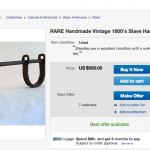By Lynda Berg
An Ebay ad boasts “RARE Handmade Vintage 1800’s Slave Handcuffs Manacles Shackles” with a sub-description under the category “item condition: Used” that extols “Shackles are in excellent condition with a working lock and key.”[1] The crassness of this boast, in combination with the next line denoting the price of $550, should disturb anyone who reflects upon their use in the production of humans as commodities. Is there not a sinister irony extant in these items, which were once commodities for the production of human commodities, and now returned to the market as a commodity in their own right, not for their use, but because of their use.
RARE Handmade Vintage 1800’s Slave Shackles
In thinking through what this re-commodification means, I am drawn to reconsider first the production of “the slave” by which these tools first functioned. In doing so, I find the article by Hortense Spillers, “Mama’s Baby, Papa’s Maybe” illuminating for this task. Spillers emphasizes the significance of the power to name in the process of controlling and commodifying a “body.” Spillers lays open the architecture behind names by relating them to the procedures of capture employed in the theft of African bodies beginning in the 15th century with the conquests of the Portuguese[2] and continuing in the Atlantic slave trade. “The captivating party does not only earn the right to dispose of the captive body as it sees fit, but gains, consequently, the right to name….”[3] This naming is part of the work of the “master” to deny past social and cultural meaning already present in the lives of these African peoples, including the denial of their identity and gender. It was a process of stripping bodies down for the purpose of creating new bodies, conformed to the body politic of colonial sovereignty, and thus malleable to the domination of the master to which they would eventually be delivered.
In this space, particularly on the slave ship, captives are first ungendered: made interchangeable with all other captive bodies on board. As Spillers notes when assessing the cargo stat sheets from slave ships, “under these conditions, one is neither female, nor male, as both subjects are taken into account as quantities.”[4] That is, as those uprooted from land and kin, “shackled” in the hull of a ship, crossing an unknown sea, persons are made into units of indistinct exchange, assuming no past, no identity, only mute exchange value.
What does it mean, that centuries later these vary shackles, these tools of stripping down, are themselves placed on another sort of sea (the internet) stripped of their narrative, and sold for an exchange value to the highest bidder? In what ways does this process actually re-inscribe the vary capture they once helped produce? The situation seems to demand a response to the (re)commodification of these shackles, and a response that escapes this capture, rather than living into it.
Again, Spillers may be helpful in imaging a possible horizon. For, when describing the stripping down of African bodies, she notes that in this moment flesh is laid bare. For Spillers this flesh is a double site: the site of negation and of potential. The flesh then is that which is anterior to the body, anterior to the subject position, it is the “zero degree of social conceptualization.”[5] While the process of commodification will always try to force upon this flesh a new state of capture (a new body known as “the slave”), the “negative,” the “criminal,” the very existence of flesh will reveal that these titles are never totalizing, and in fact there is always something that escapes capture (the flesh). Of course, Spillers is speaking of the flesh, not of inanimate objects such as shackles. But I wonder in what way the responses to these fetishized shackles can attempt to be a response of escape rather than capture? I have no complete answer, though others have suggested the idea of a collaborative purchase to place them in a space (perhaps a museum) that does not allow these objects to be disconnected from their narrative.[6] I don’t know if this is the right answer, but perhaps it is a way through, a way of resisting the break with narrative that the reduction to exchange value purports to do. Regardless, in moving forward, we must ask what pressures does the response of the flesh put upon the way these items are being stripped and sold that could reveal new potential?
[1] http://www.ebay.com/itm/RARE-Handmade-Vintage-1800s-Slave-Handcuffs-Manacles-Shackles/251414586834?_trksid=p2047675.c100011.m1850&_trkparms=aid%3D222006%26algo%3DSIC.FITP%26ao%3D1%26asc%3D20140107083349%26meid%3D4855740122817208930%26pid%3D100011%26prg%3D20140107083349%26rk%3D1%26rkt%3D10%26sd%3D250955464123.
[2] Spillers, 211
[3] Spillers, 210
[4] Spillers 215
[5] Spillers, 208
[6] For more on this idea, see that blog Daily Kos http://www.dailykos.com/story/2012/05/11/1090804/-Who-Owns-History-Slavery-Artifacts-for-Sale-on-Ebay-Let-s-Give-Them-a-Proper-Home.
